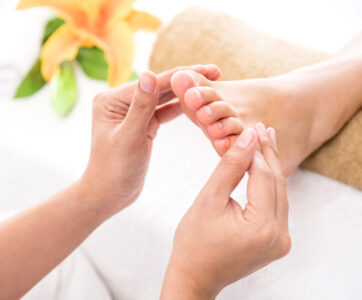 As you get older, you may notice some changes taking place in your feet or toes. One such visible change that we sometimes get asked about is when a person’s toes start to curl downward instead of lying flat when a person is seated or standing. This can occur without the onset of pain, and many people assume that everything is normal as long as there is no pain. That’s not always true, and it’s important to talk to your foot or ankle specialist if you notice that your toes are starting to curl downwards. In today’s blog, we explain why your toes might be curling under and how the issue can be treated.
As you get older, you may notice some changes taking place in your feet or toes. One such visible change that we sometimes get asked about is when a person’s toes start to curl downward instead of lying flat when a person is seated or standing. This can occur without the onset of pain, and many people assume that everything is normal as long as there is no pain. That’s not always true, and it’s important to talk to your foot or ankle specialist if you notice that your toes are starting to curl downwards. In today’s blog, we explain why your toes might be curling under and how the issue can be treated.
Curly Toe Causes
Curly toes are actually quite common in babies and infants because of how their feet develop. The tendons that help to bend the toes start out tight, causing the toes to curl under towards the sole of the foot. As they grow and learn to walk, these tendons will elongate, and most cases will resolve on their own by the time the child is five years old. However, for this blog, we’re going to focus on curled toes that affect adults.
If you’re an adult and notice that one or more of your toes are beginning to curl downwards, you could be dealing with the beginning stages of a few different issues. It’s also important to note that all of the potential issues are much more likely to be successfully treated when the deformity is flexible and mild, so don’t put off treatment simply because you’re asymptomatic or you can bear the discomfort. Curled toes could be a sign of:
Hammertoe – An abnormal bend in the middle joint of the toe. This most commonly affects your second toe.
Claw Toe – This involves an abnormal bend in both the middle and last joint closest to the toenail in your toe. It is common in any of your lesser toes.
Mallet Toe – Mallet toe is caused by an abnormal bend in the joint of the toe that is closest to the toenail.
These conditions are typically the result of prolonged exposure to tight or ill-fitting shoes. If you regularly wear shoes with a narrow toe box or tight fitting cleats or work boots, your toes may begin to curl under. Poor fitting shoes cause the toes to curl inside the shoes, which leads to tendon tightening. Over time, these tight tendons will become rigid and unable to flex back out to a relaxed state, leading to a permanent state of cured toes. It’s worth noting that bio-mechanical forces and neuromuscular diseases can also lead to curling toes.
Treatment For Curled Toes
Treatment success hinges on your ability to make changes before your tendons lose some of their natural flexibility. The simplest solution is to switch to a more roomier shoe. If you take this pressure off your toe box, your toe tendons will remain relaxed and uninjured. Switching footwear and avoiding tight shoes is the easiest way to prevent curled toes or treat the problem at the outset.
Treatment becomes a little more difficult as the tendons become more rigid. Footwear changes will be paired with physical therapy to help uncurl the toes, but if PT can’t provide solutions, surgery may be necessary. Surgery will involve lengthening these tendons, and your surgeon can walk you through the specifics should it progress to this point, but the vast majority of cases resolve when treated with conservative techniques while the problem is in its infancy.